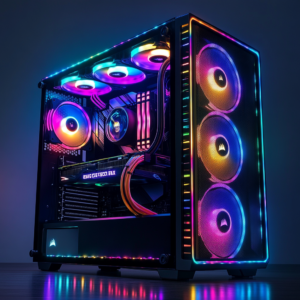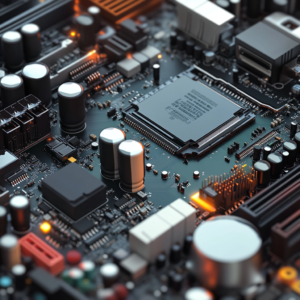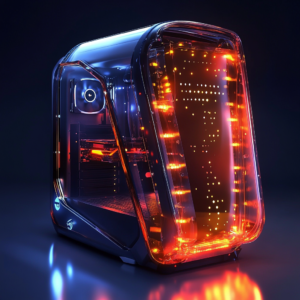1. Introduction
Welcome to my comprehensive exploration of How to Build a high-performance custom PC. In this article, I share my personal journey and insights into creating a custom-built rig that delivers exceptional performance while meeting your specific gaming, creative, or professional needs. With the right components and a methodical approach, understanding How to Build a custom PC becomes an empowering project that puts you in control of your computing experience.

I have been following the evolution of PC building trends closely, and I can confidently say that building a custom PC tailored to your requirements is transforming the way enthusiasts and professionals approach computing. In this guide, you’ll find detailed reviews, step-by-step instructions, and expert tips to help you navigate the process. Let’s dive into the world of How to Build a high-performance custom PC and discover the innovations that will empower your digital experience in 2025.
2. Benefits of Custom PCs
Building your own PC offers flexibility and upgradeability that pre-built systems can’t match. When you understand How to Build a custom PC, you can select each component based on performance, budget, and compatibility—ensuring that every part of your system meets your specific needs.
Custom PCs often feature superior cooling solutions, quieter operation, and a refined aesthetic. They also provide a valuable learning experience and a sense of accomplishment. Mastering How to Build a system designed for gaming, creative work, or professional tasks is a rewarding venture that enhances both performance and personalization.
3. Key Components Overview
Understanding the essential components is crucial for anyone looking to build a custom PC. Here are the building blocks of your rig:
Central Processing Unit (CPU)
The CPU is the brain of your computer. Choosing the right processor depends on your intended use—gaming, video editing, or running demanding applications. Consider options from Intel and AMD, keeping benchmarks and core counts in mind.
Graphics Processing Unit (GPU)
For gaming and creative tasks, a powerful GPU is essential. High-performance graphics cards provide the rendering power needed for smooth gameplay, video editing, and 3D modeling. Selecting the right GPU is a key step in understanding How to Build a custom PC.
Motherboard
The motherboard connects all the components. It’s important to choose a board that supports your CPU, has sufficient expansion slots, and offers robust connectivity options. Features like overclocking support and multiple RAM slots are crucial for future-proofing your build.
Memory (RAM)
Adequate RAM is critical for multitasking and smooth performance. Depending on your use-case, 16GB may suffice, but creative or gaming builds may benefit from 32GB or more.
Storage
Solid-state drives (SSDs) offer fast boot times and application loading, while hard disk drives (HDDs) provide larger storage capacity at a lower cost. A combination of both often balances speed and storage needs effectively.
Power Supply Unit (PSU)
A reliable PSU is essential for system stability. Choose one with sufficient wattage and efficiency certification (such as 80+ Gold or Platinum) to ensure safe and stable power delivery.
Case
The case houses all components and affects cooling and cable management. Select a case with good airflow, ample space, and appealing aesthetics. Many builders prefer cases that allow creative customization and efficient heat dissipation.

4. Choosing the Right Components
When you decide How to Build a high-performance custom PC, choosing the right components is critical. This involves balancing performance, compatibility, and budget.
Performance vs. Budget
Assess your needs. Gamers and creative professionals require high-end CPUs and GPUs, while general productivity might be served by mid-range components. Determine a balance that meets your performance expectations without overspending.
Compatibility and Future-Proofing
Ensure your components are compatible. Verify CPU socket types, RAM speeds supported by the motherboard, and that the PSU has enough connectors. Planning for future upgrades is essential for a long-lasting build.
Reviews and Benchmarks
Consult expert reviews and benchmarks to make informed decisions. External resources such as CNET and Tom’s Hardware provide in-depth analyses to help you choose the best components for your build.
Aesthetics and Build Quality
Consider the look of your PC. Cases with tempered glass panels, RGB lighting, and customizable features add both functionality and style. A well-built PC not only performs well but also reflects your personal aesthetic.
5. Cooling Solutions and Overclocking
Efficient cooling is crucial for a high-performance build. Integrating an effective cooling solution is paramount to maintain optimal temperatures and enhance component longevity.
Air Cooling vs. Liquid Cooling
Air cooling is simpler and often sufficient for most builds. However, for enthusiasts planning to overclock, liquid cooling systems offer superior thermal performance and quieter operation. Each option has its pros and cons, so choose the solution that best fits your build.
Overclocking Considerations
Overclocking can boost performance but also generates extra heat. Ensure your cooling solution can handle the increased thermal load. Investing in robust cooling maximizes performance and safeguards your components.
Cable Management for Airflow
Proper cable management is critical for efficient cooling. Neat cable routing minimizes airflow obstruction, ensuring that your cooling system works effectively.
6. Custom PC Building Process
Here is a comprehensive guide to assembling your system and understanding How to Build a high-performance custom PC.
Planning and Preparation
Gather all components, tools, and prepare a static-free workspace. Research assembly guides and videos to familiarize yourself with the process. This phase is essential for planning a build that matches your needs.
Installing the CPU and RAM
Prepare the motherboard on a clean surface, install the CPU into the socket carefully, and secure it with the retention mechanism. Then, insert the RAM sticks into the appropriate slots, ensuring they are seated properly.
Mounting the Motherboard in the Case
Place the motherboard inside the case, align it with the standoffs, and secure it with screws. Proper installation is critical for system stability.
Installing Storage and Additional Components
Mount your SSDs or HDDs in the designated bays and connect them using the appropriate cables. Install any additional components, such as Wi-Fi cards or extra fans, to complete your build.
Connecting the Power Supply
Position the PSU in its designated area and connect the main power cables to the motherboard and other components. Ensure that all connections are secure and tidy.
Installing the GPU
Carefully insert the graphics card into the appropriate PCIe slot and secure it with screws. Connect the necessary power cables from the PSU to the GPU, ensuring proper seating and clearance for airflow.
Cable Management and Final Connections
Route all cables neatly using cable ties or Velcro straps to improve aesthetics and airflow. Verify all connections, including front panel connectors, to ensure a reliable setup.
Powering On and BIOS Setup
Connect your monitor, keyboard, and mouse, then power on the system. Enter the BIOS to verify that all components are recognized and configure the boot order and other necessary settings.
7. Troubleshooting and Maintenance Tips
Even a well-built PC may encounter issues over time. Knowing How to Build a system also involves maintaining and troubleshooting your build.
Common Issues and Solutions
Issues like instability, overheating, or hardware incompatibility can occur. Check for loose connections, update drivers, and ensure that your cooling system functions properly. Regular maintenance, such as dust cleaning and thermal paste replacement, is essential.
Monitoring Software
Use software tools like MSI Afterburner or HWMonitor to keep track of temperatures, fan speeds, and component performance. These tools help diagnose and resolve potential issues.
Preventive Maintenance
Establish a routine for cleaning your PC’s internals and updating firmware and drivers. Preventive maintenance is key to ensuring that your system continues to run smoothly.
8. Cable Management and Aesthetics
Efficient cable management is essential for both optimal performance and a professional-looking build. A well-organized custom PC not only improves airflow and system stability but also showcases your attention to detail and enhances overall aesthetics.
Planning Your Cable Layout
Before you begin assembling your PC, take time to plan your cable routing. Map out the positions of your power supply, motherboard, and other components to determine the best paths for your cables. This planning phase is crucial to minimize clutter, ensure maximum airflow, and make future upgrades easier. By carefully considering your cable layout from the start, you lay the foundation for a clean and efficient build.
Techniques and Tools for Effective Cable Management
Using the right techniques and tools can make all the difference. Cable ties, Velcro straps, and cable channels are excellent for bundling and routing cables neatly throughout your case. Custom cable sleeves or modular cable kits can also add a polished look while protecting your wires from wear. Implementing these tools ensures that cables are securely fastened and organized, which not only enhances performance but also simplifies troubleshooting and maintenance.
Enhancing Visual Appeal with Customization
Beyond functionality, organized cables contribute significantly to the overall visual appeal of your build. A neat setup with minimal cable clutter creates a striking interior view, especially when paired with tempered glass panels or RGB lighting. Consider adding custom cable covers or color-coordinated ties to match your system’s theme. A visually appealing PC not only impresses onlookers but also reflects the care and expertise you’ve put into building a high-performance machine.
9. Future Trends in Custom PC Building
The world of custom PC building is constantly evolving. Future trends promise even more advanced technologies and smarter components.
Emerging Components and Technologies
Expect advancements in processor technology, memory speeds, and cooling solutions. New materials and design philosophies will lead to more efficient and sustainable builds.
Integration of AI and Automation
AI is beginning to influence PC building, with features like automated overclocking and predictive maintenance software. Future custom PCs may incorporate AI-driven enhancements to simplify troubleshooting and optimize performance.
Evolving Aesthetics and Customization
As personalization becomes more important, future PC cases and components will offer greater customization options. Modular designs and enhanced RGB integration will allow you to create a system that reflects your personality.

10. Internal and External Resources
Throughout this article, I have integrated insights that connect with various related topics on VikingBytes.com. For further reading on technological innovations and practical applications, please explore our articles on How AI is Revolutionizing Tech: Trends and Innovations and AI in Everyday Life: Practical Applications You Need to Know. Additionally, external sources such as CNET, Tom’s Hardware, and PC Gamer provide comprehensive reviews and expert opinions on the latest hardware trends. I also recommend watching this informative YouTube video: How to Build a High-Performance Custom PC Guide.
11. Frequently Asked Questions (FAQ)
Q1: What are the benefits of building a custom PC?
A: Building a custom PC allows you to choose each component based on your needs, ensuring optimal performance, upgradability, and cost-effectiveness. It also offers the flexibility to tailor your system for gaming, creative work, or professional tasks—key insights into How to Build a high-performance system.
Q2: How do I choose the right components for my custom PC?
A: Consider factors such as performance, compatibility, and budget. Reading expert reviews, consulting benchmarks, and ensuring all parts work seamlessly together are essential steps when learning How to Build a custom PC.
Q3: What cooling solutions are recommended for high-performance builds?
A: Both air cooling and liquid cooling have their advantages. For overclocked systems, liquid cooling often provides superior thermal management. Ensuring proper airflow is critical for a system that runs optimally under load.
Q4: How can I troubleshoot issues with my custom PC?
A: Regular maintenance, such as cleaning dust and updating drivers, is key. Monitoring software can help diagnose issues like overheating or instability. These practices are part of knowing How to Build a system that remains reliable.
Q5: Where can I find more resources on custom PC building?
A: In addition to this guide, check out reputable tech sites like CNET, Tom’s Hardware, and PC Gamer. They offer detailed reviews and how-to guides that complement your learning on How to Build a custom PC.
12. Conclusion
Summary of Key Points
In conclusion, the journey of How to Build a high-performance custom PC is both challenging and rewarding. Custom builds offer unparalleled performance, flexibility, and the opportunity to create a system tailored to your needs—whether for gaming, creative work, or professional tasks. By carefully selecting the right components, ensuring optimal cooling, and paying attention to cable management and aesthetics, you can create a custom PC that stands out in both performance and design.
Final Thoughts
This comprehensive guide has walked you through the benefits, key components, assembly process, troubleshooting tips, and future trends in custom PC building. Remember, building a custom PC goes beyond mere assembly—it’s about creating a machine that reflects your personal needs and style. I hope this article has provided valuable insights and practical tips to help you build a system that will serve you well for years to come.
13. Calls to Action and Affiliate Recommendations
If you’re ready to take your AI experience to the next level, I invite you to check out this tool that helps you create content by easily creating realistic digital models of people from simple descriptions and exploring the potential of artificial intelligence in digital art. Check it out here.
